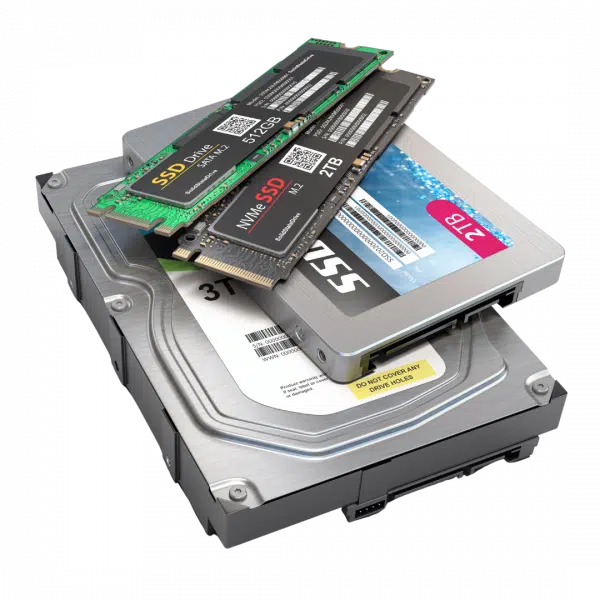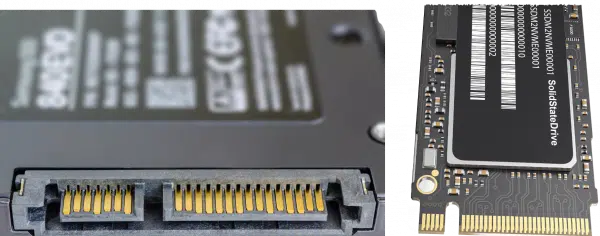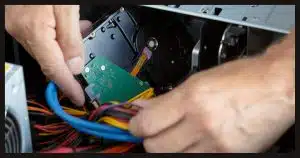My recommendation.

A working hard disk formatted for use by any prior version of Windows can certainly be read by Windows versions that come later.
Of course, you’ll have to open the old computer and extract the drive. Then you can either install it as an internal or external drive of the new machine.

Move my old hard drive to my new computer
- You can almost certainly remove the hard drive from an older machine and attach it to a newer machine.
- You may be able to install it internally.
- Consider placing it into an external enclosure to make it a USB drive.
- You will not be able to transfer installed applications or Windows itself.
Installing the drive in another machine
This is a fairly common approach if you’re comfortable dealing with hardware.
Remove the old hard drive from the old computer and install it as the second1 drive in a new one. What used to appear as the C: drive on the old computer might now appear as the D: drive on the new one. Once it’s set up, copying files from old to new is easy and fast.
This approach comes with a bonus. Once you’re done copying the files you want to keep, you can leave the old hard drive in the new machine, reformat it (or not), and use the extra disk space for whatever you like.
The downside is you need to be somewhat hardware literate to install the drive. It does mean opening up your PC and connecting the old drive in the right way in the right place. How to do it varies based on the type of computer and hard disk you have.
Help keep it going by becoming a Patron.
A more flexible approach: the external drive
A more flexible approach I prefer is to take the drive out of the old computer and install it into an external USB drive enclosure.
That’s essentially what external USB drives are: hard drives in an enclosure, providing power and a circuit board to provide the USB-to-hard-drive interface.
There are two things you need to know before purchasing an external USB enclosure.
- The physical size of the drive. The external enclosure you select must match the physical size of the old drive you’re about to put in it.

In the photo above, the drive at the bottom is a 3.5-inch drive, the next up is a 2.5-inch drive, and the two circuit boards above are M.2 form factor drives. Each requires a different size and/or style of external enclosure.
- The interface.

There are two primary disk interfaces these days: SATA (on the left, above) and the newer M.2 (on the right). Almost all machines include SATA interfaces, whereas newer machines also include M.2 interfaces for SSDs in that form factor.
Once you’ve installed the drive in the appropriate type of enclosure (a screwdriver is the only tool you’ll need), you connect it via USB to any computer (and perhaps to power), and you’ll be able to access the data on it.
What you can’t do
I want to caution you about transferring software.
You can’t.
Any program that requires running a setup program to be installed on the old machine will need that setup program run again to install it on the new machine. This is not typically available on the hard disk you just moved — you’ll need to download the latest setup for the software you want2.
Similarly, this doesn’t work for Windows. Windows is configured for the specific hardware it’s used on. Your old machine’s configuration is different than your new machine’s. Even if you could copy it over somehow, it would be unlikely to work properly. Much like an application, Windows must be set up for the machine it will run on.
Do this
Whether you install the hard disk into a different computer or an external enclosure, you need to be comfortable opening up the old computer to disconnect and remove the drive. Then, depending on your choice, you’ll need to install the drive in its new home.
If that sounds like too much, perhaps it’s time to find a technician (or at least a techie friend).
It’s usually a fairly quick and easy operation for someone who knows what they’re doing.
If you found this article helpful and you’d like more tips like this, you’ll love Confident Computing! My weekly email newsletter is full of articles that help you solve problems, stay safe, and increase your confidence with technology.
Podcast audio
Footnotes & References
1: Or third if there are already two, or fourth if there are three, etc.
2: Rarely is the setup program left on the old machine. Even if it is, it’s rarely in a state that would allow you to just run it and set up the program elsewhere. You need to re-download it or find your original installation media.






This is a great article! As a technician, I have been doing this procedure for over 30 years for various customers. Today, I shred the link to this page for someone far away, who wants the easiest and quickest way to move her files from an old drive to a new computer. I also included a Youtube link that shows the exact procedure: [link removed, content was removed from YouTube]
Leo –
Hi. New portable external hard drives are pretty cheap nowadays. However, I would consider converting an internal hard drive to an external hard drive if the internal drive, which came from an old computer that utilized only the slow 2.0 USB connection, can be transformed into an external drive that utilizes the faster 3.0 USB connection.
1. Is this conversion to a faster USB connection possible?
2. Which hardware (enclosure, interface, cable, etc.) is it that makes this faster connection possible?
3. Will a different driver be required? If so, will it be difficult to acquire?
I don’t know if attempting such a conversion would be cost effective, but I would like to know if it’s even possible or easy enough to do to begin with.
Thanks.
1. Yes, 2. the USB speed is a function of the external drive housing or adapter, not the drive itself. If you get a USB 3 housing, you should get USB 3 speeds.
3. From my experience, all are plug and play.
The computer being connected to must also support USB 3. Technically obvious, but also easy to overlook.
I am curious what your thoughts are about Laplink’s PC Mover software for moving programs and files from an old PC to a new one?
Here’s what Leo said about PC Mover previously
Can I move a program from one computer to another?
I have used PC Mover 6-8 times in the past with very much success. Most recently I went from a Windows 10 to a Windows 11 PC with a very high success rate. I recommend using a crossover cable, PC to PC, for rapid transfer rather than going through a network. It costs about $39 for each PC to PC transfer and took 3-4 hours, dependeing on file size. Not bad when you consider the time it would take to reinstall all of that info. All apps and data files trasnsfer, but of course, not the OS. I highly recommend it.
Hi Leo,
It seems that an easier solution would be this: Assuming that you have an image backup using Macrium Reflect on an external HD – you can then access any file or folder on that external HD. Just simply copy all of the folders from the external hard drive to your new PC. That seems to be a much easier solution. Is there anything wrong with this solution?
Mike W.
That would work if you have a backup. Leo’s method would also get any files added to the disk after the backup.
That works, and I’ve done it. I prefer to extract the hard disk and put it in an enclosure — not only the latest files, as Mark points out, but I now have a handy external drive.
I have a slightly different situation. My brand new Windows 10 computer came with a 256GB ss hard drive. My old Vista computer has a 1TB HD. I want to use my old computer’s 1TB drive instead of the new 256GB drive. Basically, I want to transfer the Windows 10 components from the new computer’s HD to my old 1TB HDD and remove the 256 drive. How would I be able to accomplish this? Right now I’ve already got the 1TB installed in the new computer and can access it’s files through File Explorer.
This could get tricky.
Assuming you don’t need to save anything on the 1TB drive, you can image backup the SSD, and then restore it to the 1TB. You may need to adjust partitions after to take full advantage of the space. You may also need to remove the SSD and/or change boot settings in the BIOS/UEFI as well to make sure it boots from the correct drive.
Assuming you do need to save data on the 1TB drive, I’d play with partitions on it. (Back up first, of course.) You’ll need to be able to make at least 256GB space available. Then using a partition tool of some sort shrink the existing partition, create a new partition of 256GB, restore the SSD image to it, and then see if you can get it to boot from that partition. If so, you can then return to the partition tool to merge the partitions, or somehow manage the data if you didn’t want it to appear as a separate drive.
One exception to “I want to caution you about transferring software. You can’t.” Portable apps.
I run a lot of software from PortableApps, including browsers, utilities, music and graphics software, etc. When I replaced my Windows 7 computer with a Windows 10 computer, I just copied the installation folders for all my portable apps over to the new machine and the programs were ready to go, with all my settings, bookmarks, history, etc preserved. The only software I actually had to install were the programs that don’t have a portable version, such as Macrium and a few others.
Which is fantastic — for those that know about portable apps, and for whom portable apps work (by that I mean the software they want to use is available in that form). As you point out not everything is available that way — I’d even say most commonly used software is not. If it required a “setup” program, then you can’t transfer it.
I have a new PC with Windows 10. My old PC had Windows 7. I put the old Hard Drive with Windows 7 in an external unit. When I access the old hard drive, much of the information such as emails, documents, downloads, etc. are just a bunch of letters and numbers. Is there anything that can be done to be able to use the old hard drive in an external unit and make sense of what is in the emails, etc.
Thanks so much for your time and help. I really appreciate it.
Have a good day.
Generally you’ll need to use the same program that created those files in order to read those files. OR using a similar program to import those files (like a new email program to import the old email). Exactly what and how depends on a very long list of specifics and varies depending on your situation.
I’ve bought a new desktop with Windows 10 and have an external hard drive [Windows 7] from my old laptop [now sold w/o the drive]. All I need are some photos and videos off the external drive. Once I get Windows 10 to play nice and recognize the external drive via SATA connection, would I be able to access these files to copy? It was suggested to use a virtual drive on Windows 10 to achieve this. So, would either approach work? It’s best to know this before I begin, eh?
Connecting the drive as an external hard drive should work. Not sure what’s meant by a “virtual” drive in this context.
PC Magazine says you can do this with Windows 8 or Windows 10, but you’ll need your Windows activation key. The link to the article is below.
I built my old PC myself (way back in the early 2010s.. I think 2011), but it was originally Windows 7. I got the free migration to Windows 10 and have been using it ever since. When I built a new computer, I used my old hard drive. It took a while to load, but it worked fine… again, I just needed an activation code which I no longer had, so I found a website selling keys for just over $30. I did some research on Kinguin, and they buy keys from wholesalers who had excess keys and just want to get SOMETHING for them. So they can get them cheap and sell them to us cheap. You can also buy a new key from Microsoft, and I assume your new PC SHOULD have a key as well, to activate the version on the new hard drive.
Leo, I love you and love your stuff here, but I believe some of it may be a bit outdated. This article is from way back in 2005… when this would have been, in fact, impossible to do, as they article correctly states.
Here’s the link to the PC Magazine article: https://www.pcmag.com/how-to/how-to-move-your-windows-drive-to-a-new-pc
I still don’t recommend moving a hard disk from one computer to another to be used as the primary/windows drive. That’s not how you move Windows. In my opinion, it remains too risky. This article is about moving the drive to another machine as a secondary drive, which is a great way to move data.
Check the date up above and you’ll see this article was updated June 10, 2020.
(With 5,000 articles on the site it’s impossible to keep every article 100% up to date at all times. I do regularly revised the articles I consider to be important or relevant, though. Like this one.)
“What used to appear as the C: drive on the old computer might now appear as the D: drive on the new one.”
This is true in most cases, but in many other cases it might get another drive designation like E: or F: etc. if your system drive came partitioned and other possible circumstances.
On 2 different computers I had serious problems with the ownership of the files on the old HDD (using the old HDD as a second drive after installing a SSD a bootdrive and re-installing Windows).
I had to copy the files to two (in case of failure) FAT32 media, formatting the old HDD and then copying the files back.
Common problem. This article can help: https://askleo.com/permission-to-access-this-folder/
PcMover does work quite well. It will move data, applications and accounts from the old pc to the new one over ethernet or wifi. I used it to broadcast bring up a new machine. The trick is the old machine has to still work.
There is an alternative to using a external drive enclosure: Look up “sata to usb adapter”. This is cheaper and easier to use – don’t even need a screw driver.
Which is fine for temporary use. I have a couple of these. But if the drive still works a traditional enclosure leaves you with a handy external drive you can then use as you wish.
They are the essentially the same, but without a case. I’ve found the prices to be similar and sometimes an enclosure can be a couple of bucks cheaper. A sata to usb adapter is more flexible, but if you want to keep it as external storage, an external enclosure might be preferable.
This article caught my attention, as I’m about to move my brother’s old hard drive to his new computer, where it will act as the data drive. He will keep the new machine’s SSD with Windows 11 as the system drive.
I would be glad of advice as to how the Windows TPM encryption will affect matters in this scenario, and if he should turn it off. He does not appear to be anxious to increase security.
I currently have an HP All-In-One that has the Blue Screen of Death. Yeah! I have a lot of files on it that I desperately need. I have been trying to slowly get my files onto a thumb drive but I am having trouble getting the computer to stay “alive” long enough to get them. I have taken regular computer towers apart with no problem. But, this one is different. Is there a way to connect this computer to another computer that would serve as the operating system so I can bypass the BSOD and get to my files to save?
Not really. In your case I’d be tempted to take out the hard drive and put it in an external enclosure.